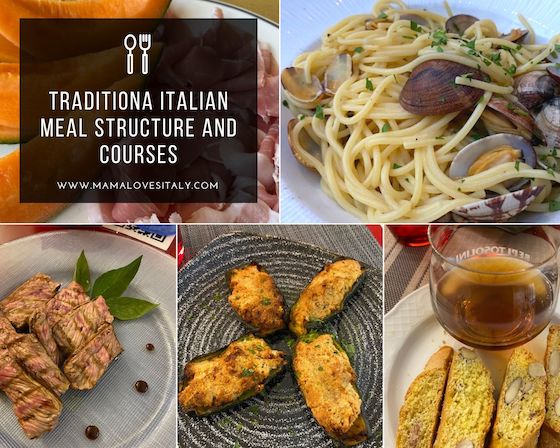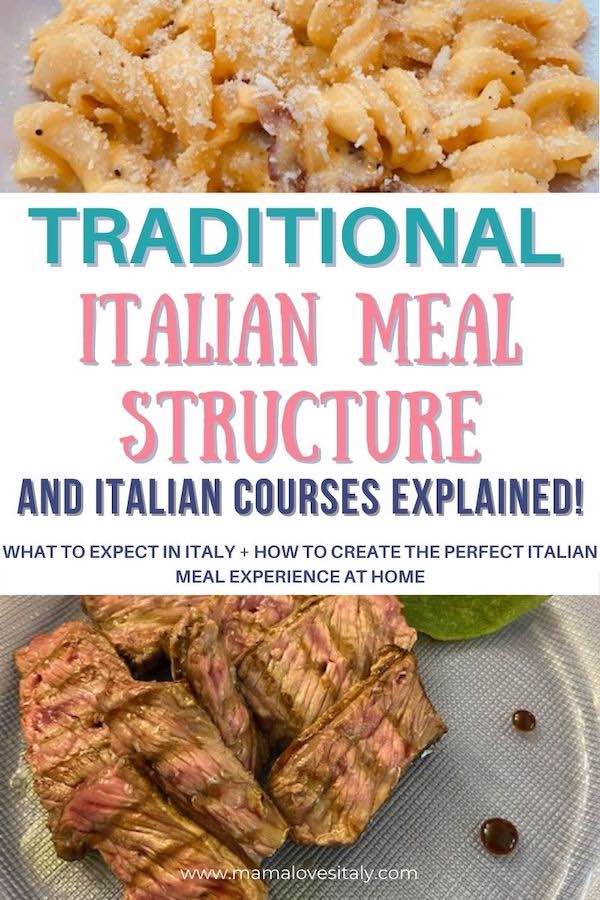
Traditional Italian meal structure and courses: all you need to know + how to recreate it at home
All you need to know about the traditional Italian meal structure: traditional Italian meal courses, how to read a menu, how to replicate a traditional Italian meal at home.
Traditional meal structure confuses many.
Colazione (Breakfast), pranzo (lunch), and cena (dinner) are reasonably well known, but how about merenda? Or aperitivo?
Fear not! This is all you need to know about the traditional Italian meal structure, how this has changed over the years and how you can recreate a wonderful Italian meal at home!
In this post, we will cover:
- Italian meal courses names
- Traditional Italian meal structure
- The traditional Italian meal structure today (what to expect)
Italian meal courses: names and terms you need to know
First, a short Italian lesson!
Traditional Italian meals
- Colazione – breakfast (Morning, anytime before 11, usually)
- Pranzo – lunch, usually served between 1pm and 2.30 pm
- Cena – dinner, usually between 8pm and 9.30pm
- Merenda – snack time (for kids), mid morning – mid afternoon
- Aperitivo – pre-dinner drinks and snacks/food, usually between 7 and 8
Traditional Italian meal courses
The traditional Italian meal sees several courses. These are traditional in bigger meals at home and also what you see on Italian menus in restaurants.
They are:
- Antipasti – starters / appetizers. You find a huge variety of these, depending on the region you are in, restaurant, seasons etc.
Usually, you can expect bruschetta/ crostini, small salads, fried food, pates, seafood salads etc but the only limit truly is the creativity of the chef!
- Primo: lit. ‘first’ – this is the category that includes all pasta dishes and rice options as well as local specialties such as canederli/knoedels.
Usually served after a starter, this can often be ordered as your only main course
- Secondo: lit. ‘second’ – this is usually a protein based course of meat or fish and it is called ‘second’ because it comes after the first course, pasta.
In recent years, more and more variation and vegetarian options have become popular as a secondo so this is now quite a wide category of meals. It is common to order a secondo as your main course, usually accompanied by a starter or a contorno (see below)
- Contorno – contorno means side dish served with secondo, and usually involves sauteed vegetables or roast potatoes.
While sometimes you can pick a contorno as a starter, Italian traditional meal structure does not foresee a contorno as a side to pasta (aka: lasagna and fries is a no-no)
- Frutta e dolce Frutta (lit. Fruit) and dolce (sweet= dessert) are the closing courses in a traditional Italian meal structure.
Frutta in restaurants is usually served as macedonia (fruit salad) or in the form of fancier fruit choices such as luscious slices of watermelon, pineapple or berries.
Desserts come in all shapes and sizes depending on the restaurant and region you are in.
Frutta and dessert are an alternative of one another in restaurants meaning you don’t usually order macedonia and then tiramisu.
- Digestivo and Caffe’ – after a large meal, a traditional Italian meal would be followed by an offer of coffee and, especially after dinner, digestif such as limoncello, amaro, sambuca etc. Learn all about Italian digestive drinks here.
The coffee served after lunch is espresso, usually black (no milk). Milky drinks are usually avoided after a meal and this why you sometimes hear Italians don’t drink cappuccino late in the day.
Good to know! If you attend an Italian formal dinner, you should expect all these courses to be served (at weddings or Christmas, usually more than one dish per category) however, you don’t need to order one of each every time you eat out!
While the courses are there as an option, it is more and more common to order a meal with only a selection of them, for instance, appetizer and pasta or meat.
Traditional Italian meal structure
Colazione – Breakfast
Colazione is the Italian name for breakfast. It is the first meal of the day and you can have it at home (colazione a casa) or ‘al bar‘ (at the cafe).
A traditional Italian breakfast at home usually involves:
- A coffee drink, often made with an Italian stove top coffee maker or espresso machine, with or without sugar and milk to taste
- Tea, while coffee is usually associated with Italy more than tea, black tea is pretty popular in Italy too
- Cocoa milk for kids
Bread or ‘fette biscottate‘ (Italian gallettes) with butter and jam.
Breakfast ‘al bar’ (at the cafe) usually involves a coffee drink such as coffee (espresso), cappuccino or latte macchiato (similar to what abroad is called latte) and a cornetto (Italian croissant).
Breakfast is a morning meal however, you can have breakfast at a cafe’ almost any time of the morning.
Usually, however, after 11am, you find fewer pastry options and the offering turns more towards sandwiches/lunch options.
Keep reading for more info on Italian traditional meals! Enjoying this post? Save it for later too!

Pranzo – Lunch
Pranzo is the Italian word for lunch.
Lunch is maybe the meal that most changed over the course of the last decades, changing from a rather filling affair to a much lighter one.
A traditional lunch would have had several courses such as antipasto, primo, secondo, contorno, dolce and caffe’.
While this would have been the traditional way to have lunch, if you now meat a friend for lunch in Italy or go with a co-worker, you are unlikely to go for the full affair.
Most commonly, lunch in Italy now is one main course: this can be a primo or a secondo, or a large salad bowl. ‘Insalatone‘ (big salads) are hugely popular in Italy!
A glass of red wine with lunch is perfectly acceptable even when going for a simple meal.
Merenda
Merenda is not a meal as such but rather the name given to children snack time. The expression is ‘fare merenda‘ and applies for morning snack and afternoon snack.
Common merenda foods for kids are bread and prosciutto, biscuits, pizza (not the round type, the bakery type) or more and more often packaged snack of various types.
Aperitivo
Aperitivo in not a traditional Italian meal as such but rather a pre-dinner meetup with friends with drinks and snacks or food.
Aperitivo comes in several forms.
In its most simple incarnation, aperitivo foresees a drink and snacks, usually crisps and peanuts: the drinks of choice in this case are usually non alcoholic soda drinks such as Campari soda, Sanbitter or Crodino.
In its full our form, more and more common, aperitivo foresees drinks and a lot of food, ranging from finger food to pasta and rice dishes.
This used to be served as a large buffet but 2020 saw the end of that so now it is often served as a selection coming to your table
Most aperitivo are in between these two extremes: you usually have it sitting at a table and foresees drinks (alcoholic or not) and finger food.
Traditional aperitivo drinks are:
- Campari soda
- Aperol soda
- Crodino
- SanBitter Bianco or Rosso
- Tomato juice (condito or not, ‘dressed’ or plain)
- Aperol spritz (alcoholic)
- Campari spritz (alcoholic)
- Prosecco (alcoholic)
- Beer (alcoholic, craft beers becoming more and more popular)
- Cocktails (Negroni and Americano are favorites)
You can learn all about Italian aperitivo, history and traditions here.
Is the traditional Italian meal structure still in use?
The full on Italian meal structure is still very much in place but it is more and more common to deviate for it outside of formal meals.
Especially at lunch, it is very common to only go for one main course and maybe a starter or a dessert however, the traditional Italian courses still influence meals.
When picking from a menu of cooking at home, it is common to still think of a meal as made by all the courses and include some of each even if going just for a main (basically as a way to make sure you include all full types in all meals).
Families with kids are still very much using the traditional meal structure especially at dinner, to make sure to offer balances nutrition with carbs (usually primo), proteins (secondo) and vegetables (contorno).
I hope you enjoyed this overview of the Italian traditional meal structure and traditional Italian courses. Buon appetito!




